SPLINTERS
Tennessee Valley Woodworkers
 Vol. 16/ Issue4
April 2001
Editor: Tom Gillard Jr.
Vol. 16/ Issue4
April 2001
Editor: Tom Gillard Jr. 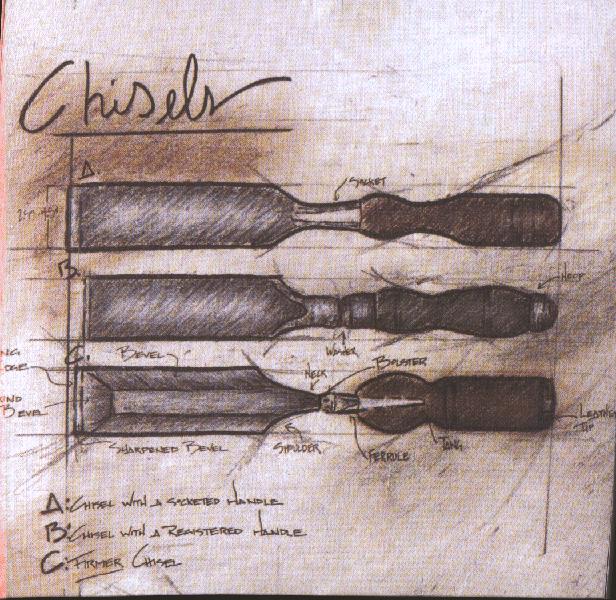

Meeting Notice:
The next meeting of the TN Valley Woodworkers
Will be held, April 17 at 7:00 p.m. in the
Duck River Electric Building, Decherd, TN
All interested woodworkers are invited!


The following people have agreed to serve as contacts for their particular
skills. If you have questions, suggestions
for activities, or other comments relating to these skills, please
call these folks. Their interest is to help the
club better serve their area of expertise. Your participation
with them will help them achieve that goal.
Alice Berry 454-3815 Design
Phil Bishop 967-4626
Finishing
Tom Church 967-4460 Turning
Harry May 962-0215
Carving
Bob Reese 728-7974 Sharpening
Jim Van Cleave 455-8150 Jointery
Maurice Ryan 962-1555 Health and Safety

Calendar of Events
Event
Date
Spring Workshops
TBD
Spring Seminar
4-21
Turning "bee"
5/12
Summer Picnic
6/23
Fall Seminar
TBD
Coffee County Fair
9/20-22
Christmas Party
12/7
Its a rare project that doesn't require some attention to the potential
for wood movement. So keep the following strategies in mind no matter what
you're working on.
STRATEGY 6: If a workpiece is warped, true it up by face- or edge-jointing
before you rout, saw, or assemble it for your project. Don't attempt
to force the board into flatness with clamps; the warpage will show up
invariably in your finished project.
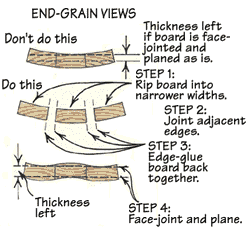 STRATEGY 7: Cupped or twisted boards can lose practically all of their
thickness by the time you joint one face to flatten it, and thickness-plane
the other face to flatten it as well. To preserve most of the thickness
of such boards, rip them into two or three narrower pieces as shown in
Step 1 below. Then, edge-joint these pieces and edge-glue them together
into as flat a glue-up as possible. After the glue dries, face-joint and
thickness-plane the glue-up. You'll come out with more usable stock.
STRATEGY 7: Cupped or twisted boards can lose practically all of their
thickness by the time you joint one face to flatten it, and thickness-plane
the other face to flatten it as well. To preserve most of the thickness
of such boards, rip them into two or three narrower pieces as shown in
Step 1 below. Then, edge-joint these pieces and edge-glue them together
into as flat a glue-up as possible. After the glue dries, face-joint and
thickness-plane the glue-up. You'll come out with more usable stock.
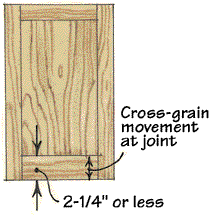 STRATEGY 8: Severely bowed boards may require more drastic measures. If
you come across a board seriously bowed along its length, cut the board
into shorter lengths before jointing its edges. That will help you
preserve the width of the workpieces.
STRATEGY 8: Severely bowed boards may require more drastic measures. If
you come across a board seriously bowed along its length, cut the board
into shorter lengths before jointing its edges. That will help you
preserve the width of the workpieces.
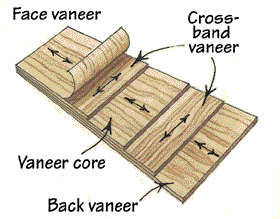 STRATEGY 9: Minimize the width of cross-grain workpieces, such as the rails
in a rail-and-stile cabinet door. Because the grain in rails runs at 90
degrees to the stiles, conventional wood-movement theory suggests that
this joint would not hold up well. But, because the rails are typically
less than 2-1/4" wide, their movement is slight enough that a joint glued
and reinforced with dowels, biscuits, or pocket screws will not come apart.
STRATEGY 9: Minimize the width of cross-grain workpieces, such as the rails
in a rail-and-stile cabinet door. Because the grain in rails runs at 90
degrees to the stiles, conventional wood-movement theory suggests that
this joint would not hold up well. But, because the rails are typically
less than 2-1/4" wide, their movement is slight enough that a joint glued
and reinforced with dowels, biscuits, or pocket screws will not come apart.
Likewise, the pieces of a mitered picture frame will fight against each
other under changing humidity levels. To prevent wood-movement problems,
it's a good idea to keep these pieces no more than 3" wide.
STRATEGY 10: It also pays to make the cross-grain dimension of tenons
no larger than necessary. That's because the wider you make a rectangular
tenon, or the larger in diameter you make a round tenon, the more that
tenon will swell and shrink. And the more they move, the greater the likelihood
that they will loosen over time.
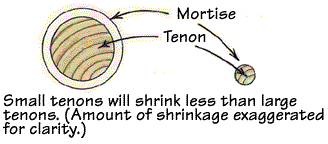 STRATEGY 11: Use plywood, melamine-coated particleboard, and other "engineered"
wood products when you want to avoid wood-movement problems. These products
are much less apt to move than solid wood because the veneers or chips
that make them up run in opposing directions. So, if you simply don't have
the time, skill, or inclination to make flexible joints, and plywood or
particleboard will serve the purpose, use it!
STRATEGY 11: Use plywood, melamine-coated particleboard, and other "engineered"
wood products when you want to avoid wood-movement problems. These products
are much less apt to move than solid wood because the veneers or chips
that make them up run in opposing directions. So, if you simply don't have
the time, skill, or inclination to make flexible joints, and plywood or
particleboard will serve the purpose, use it!
However, even if you prefer to work with only solid stock, you still
should use plywood for your drawer bottoms. Why? When we build drawers,
we like to use the bottom to square up the drawer. This requires that the
bottom fit tightly into its grooves, leaving no
room for expansion. By doing so, we also can glue the bottom into place
knowing that the bond won't break. We've seen many drawer bottoms made
of solid wood that have cracked or caused the sides of the drawer to push
out and bind.
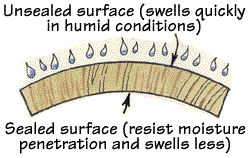 STRATEGY 12: When applying finish to your projects, always use the same
finish--and the same number of coats--on all surfaces of the project parts.
The finish helps prevent wood movement in two important ways. First, the
finish helps prevent a sudden change in the moisture content of the wood
by slowing down the gain or loss of water during sudden ups and downs in
seasonal humidity.
STRATEGY 12: When applying finish to your projects, always use the same
finish--and the same number of coats--on all surfaces of the project parts.
The finish helps prevent wood movement in two important ways. First, the
finish helps prevent a sudden change in the moisture content of the wood
by slowing down the gain or loss of water during sudden ups and downs in
seasonal humidity.
And, coating both surfaces of a workpiece helps prevent warpage. How?
A board that's finished on one side and not on the other will gain or lose
water at different rates on the two surfaces. Then, the two surfaces will
move at different rates, causing the workpiece to warp.
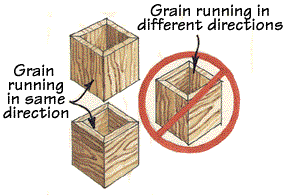 STRATEGY 13: Always try to run the grain of your glued workpieces in the
same direction. This way, the pieces will expand together, not in opposition.
STRATEGY 13: Always try to run the grain of your glued workpieces in the
same direction. This way, the pieces will expand together, not in opposition.
For example, if you glue up a cutting board with grain running in different
directions, workpieces swelling across their widths will be trapped by
opposing pieces that do not swell along their lengths. Under these
conditions, something has to give, and either the workpieces or the glue
joints will split.
When you must join workpieces with opposing grain directions for aesthetic
or functional reasons, you need to devise a flexible joint.
March
Show & Tell:
John &Josh Thompson-turned lamp bases
John Sargent-Valentine Box made from wood from Puerto Rico.
John Mayberry- Box elder and Black gum bowl
Ben Whiteaker-Cherry mantle clock
Steven Savelle-Whittled and carved figures
Ken Gould-cherry mallet, crotchwood vase
Kenneth Clark-Ash lamp base
Don Helton-Titans shelf, Christmas ornaments, all done on the scrollsaw.
Manuel Brown-Mosaic turned bowls
Loyd Ackerman- showed another mistake made in turning split spindles.
Visitors:
Ray Torstcarson
Steve Shores
Andy Butterfield
Loyd Weaver
Ken Miller
Hugh Hearst
--------------------------------------------------------
For, lo, the winter is past, the rain is over and gone;
the flowers appear on the earth; the time of the singing of birds is come,
and the voice of the turtle is heard in our land.
Song of Solomon
2001 Spring Seminar
Lathe Techniques for Woodworkers
Price: $5 for members and $25 for non-members
Date: April 21, 2001
Place: Foothills Crafts classroom Woodbury Highway (53) Manchester
Instant Gallery in Foothills Store
Registration 8:00 to 8:30 AM
Beverages and Pastries
One hour lunch break Local restaurants or bring your own
Morning Program Doyle McConnell
Basics for Beginning Woodturners
Lathe and its parts
Centers
Drives or Driving methods
Basic Tools
Sharpening and types of Steel
Types of Turning
Wood Selection
Sanding
Finishes
Embellishments
Afternoon Program
Split spindle turning Loyd Ackerman
Roughing out a bowl Tom Cowan
Discussion,questions, answers Matt Brothers
ROUTER DRAWING
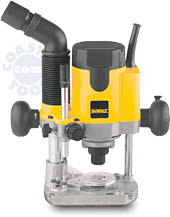
Just a reminder to resister at the April meeting for the router drawing.
Remember that the only way you can register is to be at the meeting.
Henry wants to remind everyone that DUES are due.

$10 for singles
$12 for families

WEB
SITES of INTEREST
Arrowmont
School of Arts and Craft
WOOD
ONLINE newsletter
Falls Mill
Appalachain
Center for the Arts
Forest
Products Lab. 1999 Wood Handbook
Jim DelToro
Highland Hardware
Woodworker's
Journal
Steve
Graham's Page


Saw Blade Sharpening Services: Branching Out is now offering their
services as a drop off spot to have your saw blades sharpened. The
blades will be picked up (Tuesdays), sharpened, and dropped back off at
Branching Out. The Leitz Tooling Systems out of Collierville, TN
will do the sharpening. Call (393-0525) or stop by for details.
Webmaster:
Tom Gillard Jr.
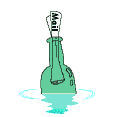
 Vol. 16/ Issue4
April 2001
Editor: Tom Gillard Jr.
Vol. 16/ Issue4
April 2001
Editor: Tom Gillard Jr. 
![]()








